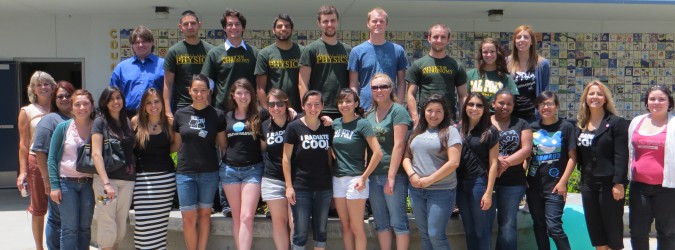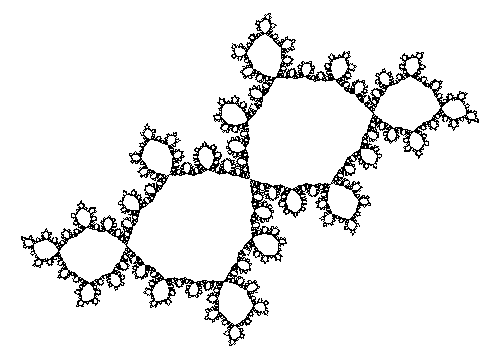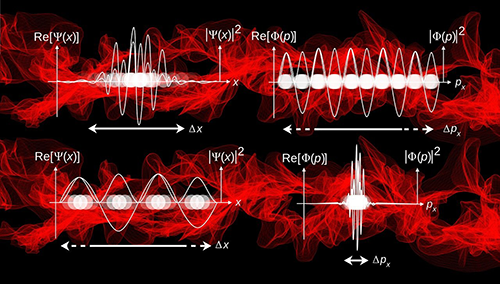Physics Education Research

Physics Education Research (PER) faculty at Cal Poly Pomona combine the fundamental “knowledge about learning” and the “discipline specific knowledge of physics” to investigate ways of making the teaching and learning of physics more effective. PER faculty conduct research, curriculum development, and instruction to improve student conceptual understanding in physics and physical science from elementary through college. Our faculty study questions of how students learn in both lower-division and upper-division classes in Physics and Astronomy, and how to develop, implement, and test the effectiveness of pedagogical learning strategies and technology designed to maximize student learning.

Qing Ryan
Associate Professor
Professor Ryan has the following research interests:
- Development of web-based computer coaches to improve students' physics problem-solving skills, at both the high school and college level.
- Studying student difficulties in upper-level physics courses.
- Understanding student difficulties of using mathematics in junior level E&M problem-solving.
- Development of research-based assessments in junior level E&M.
- Effectiveness of different range of scientific inquiry approaches in preparation of prospective and practicing k-12 teachers.
Her recent work involves studying student difficulties of using complex exponential math in junior level electrodynamics. She is also working on the development, validation, and statistical reliability tests for a new multiple-choice Electrodynamics Assessment Tool. Another project she is working on is the development of web-based computer coaches for high school physics.

Homeyra Sadaghiani
Professor
Professor Sadaghiani has a broad range of research interests including:
- Studying student difficulties in upper level quantum physics in two paradigms: Spin First vs. position first
- Development and validation study of research-based assessments in upper-level quantum mechanics
- Measurement of scientific reasoning ability and conceptual understanding of physics content.
- Effectiveness of different range of scientific inquiry approaches in preparation of prospective and practicing k-12 teachers.
- Conceptual and mathematical barriers to students learning quantum mechanics.
- Design and implementation of web-based instructional technologies and study of Hybrid-online and flipped classroom formats.
- Effectiveness of different curricula, course transformations, and pedagogical strategies.
Her recent work involves comparing two different approaches in teaching quantum mechanics: “wave-function” (starting with continuous basis) vs. “spin first” (starting with discrete basis). She is also working on the development, validation, and statistical reliability tests for a new multiple-choice Quantum Mechanics Assessment Tool, which measures student learning of basic quantum topics. Her experimental techniques and analyses include student interviews, diagnostic tests, attitude and motivation surveys, exam question and video analysis.
Selected Publications
S. Pollock, G. Passante, H. Sadaghiani, “Adaptable research-based materials for teaching quantum mechanics," American Journal of Physics 91, 40 (2023); https://doi.org/10.1119/5.0109124
B. Schermerhorn, G. Corsiglia, H. Sadaghiani, G. Passante, S. Pollock, “From Cartesian coordinates to Hilbert space: Supporting student understanding of basis in quantum mechanics”, Phys. Rev. Phys. Educ. Res. 18, 010145 (2022),https://link.aps.org/doi/10.1103/PhysRevPhysEducRes.18.010145
G. Corsiglia*, B. Schermerhorn, H. Sadaghiani, Armando Villaseñor*, Steven Pollock, and Gina Passante. “Exploring student ideas on change of basis in quantum mechanics,” Phys. Rev. Phys. Educ. Res. 18, 010144 (2022)
URL: https://link.aps.org/doi/10.1103/PhysRevPhysEducRes.18.010144
J. Wells, H. Sadaghiani, B. Schermerhorn, et al. “A Deeper look at question categories, concepts, and context covered: Modified module analysis of quantum mechanics concept assessment,” Phys. Rev. Phys. Educ. Res. 17, 020113 (2021),10.1103/PhysRevPhysEducRes.17.020113
B. Schermerhorn, H. Sadaghiani, A. Mansour*, G. Passante, and S. Pollock, “Impact of context on students' sense-making of expectation values,” Phys. Rev. Phys. Educ. Res. 17, 020141 (2021), 10.1103/PhysRevPhysEducRes.17.020141
G. Passante, B. Schermerhorn, S. Pollock, and H. Sadaghiani, “Time Evolution in Quantum Systems: A Closer Look at Student Understanding”, European Journal of Physics 41, 015705 (2020).
B. Schermerhorn, H. Sadaghiani, G. Corsiglia*, G. Passante, and S. Pollock, “Exploring and Supporting Physics Students’ Understanding of Basis and Projection, Research in Undergraduate Mathematics Education (RUME) Boston (2020)
B. Schermerhorn, G. Passante, H. Sadaghiani, and S. Pollock, “Exploring student preferences when calculating expectation values using a computational features framework,” Phys. Rev. Phys. Educ. Res. 15, 020144 (2019).
B. Schermerhorn, A. Villasenor*, D. Agunos*, H. Sadaghiani, G. Passante, and S. Pollock, “Student Perceptions Of Math-Physics Interactions Throughout Spins-First Quantum Mechanics,” PERC Proceedings [Provo, UT, July 24-25, 2019], edited by Y. Cao, S. Wolf, and M. B. Bennett, doi:10.1119/perc.2019.pr.Schermerhorn (2019)H. Sadaghiani, G. Passante, and S. Pollock, “Student sense-making and interpretation of quantum mechanical expectation values,” AIP Proceeding, Phys. Edu. Conference, 2018 Physics Education Research Conference Proceedings, doi:10.1119/perc.2018.pr.Sadaghiani Washington DC (2018)
G. Passante, H. Sadaghiani, S. Pollock, and B. Schermerhorn, “Students' choices when solving expectation value problems,” Phys. Edu. Conference, 2018 Physics Education Research Conference Proceedings, doi:10.1119/perc.2018.pr.Passante, DC (2018)
S. Pollock, H. Sadaghiani, and G. Passante, “Designing, validating, and contrasting closely related conceptual quantum mechanics questions for spin states and spatial wavefunctions,” AIP Proceeding, Phys. Edu. Conference, 2018 Physics Education Research Conference Proceedings, doi: 10.1119/perc.2018.pr.Pollock, DC (2018)
Q. Ryan, T. Chau*, H. Sadaghiani, and G. Passante, “Investigate Students’ use of Boundary Conditions using Symbolic Forms,” AIP Proceeding, Phys. Edu. Conference, pp. 344-347, doi:10.1119/perc.2017.pr.081 (2017)
T. Jayasinghe*, H. Sadaghiani, “Students’ understanding of continuous charge distributions,” American Institute of Physics (AIP) Proceeding, Phys. Edu. Conference, Cincinnati, OH (2017)
H. Sadaghiani, “Spin First Vs. Position First Instructional Approaches To Teaching Introductory Quantum Mechanics” American Institute of Physics (AIP) Proceeding, Phys. Edu. Conference, Washington DC. (2016)
Homeyra R. Sadaghiani and James Munteanu, "Spin First instructional approach to teaching quantum mechanics in sophomore level modern physics courses.” (2015) Physics Education Research Conference Proceedings, AIP Press 2015, 287-290, Maryland. 10.1119/perc.2015.pr.067
Homeyra R. Sadaghiani and Steven J. Pollock , "Quantum mechanics concept assessment: Development and validation study,” (2015) Phys. Rev. Special Topics: Physics Education Research 11, 010110, DOI: 10.1103/PhysRevSTPER.11.010110
Q. X. Ryan, S. Pollock, and B.Wilcox. “Student difficulties with boundary conditions” (2015). Physics Education Research Conference Proceedings, AIP Press 2015, 283-286. http://dx.doi.org/10.1119/perc.2015.pr.066
Q. X. Ryan, E. Frodermann, K. Heller, L.Hsu, and A.Mason. “Computer problem-solving coaches for introductory physics I: Design and usability studies”, Physics Review Special Topics. http://journals.aps.org/prper/accepted
Bethany R Wilcox, Marcos D Caballero, Charles Baily, Homeyra Sadaghiani, Stephanie V Chasteen, Qing X Ryan, Steven J Pollock"Development and uses of upper-division conceptual assessment” Physical Review Special Topics-Physics Education , Phys. Rev. ST Phys. Educ. Res. 11, 020115 (2015)
Q. X. Ryan, C.Astofil, C. Baily and S. Pollock. “Validation of a Conceptual Assessment Tool in E&M II”. Physics Education Research Conference Proceedings, AIP Press 2014, 231-234. http://dx.doi.org/10.1119/perc.2014.pr.054
H. Sadaghiani, Miller, and Pollock, “Constructing a Multiple-Choice Assessment For Upper-Division Quantum Physics From An Open-Ended Tool,” (2013) Physics Education Research Conference, American Institute of Physics Conf. Proc., Portland, OR
Q. Ryan, E. Frodermann, K. Heller, L.Hsu, and B.Aryal. “Designing a Useful Problem Solving Coach: Usage and Usability Studies”. Physics Education Research Conference Proceedings, AIP Press 2013. p. 309-312. http://dx.doi.org/10.1119/perc.2013.pr.065
H. Sadaghiani, “Controlled Study on the Effectiveness of Multimedia Learning Modules for Teaching Mechanics.” (2012) Phys. Rev. Special Topics: Physics Education Research 8, 010103
Lindsey, Hsu, Sadaghiani, Taylor, and Cummings, “Positive Attitudinal Shifts with the Physics by Inquiry Curriculum Across Multiple Implementations” (2012) Phys. Rev. Special Topics: Physics Education Research 8, 010102
H. Sadaghiani and Aguilera, “Mathematical vs. Conceptual Understanding in Introductory Physics: Where do we draw the line?“ (2012) Physics Education Research Conference, American Institute of Physics Conf. Proc., 1513, 358-361, Philadelphia
Q, Xu, K. Heller, L.Hsu, and B.Aryal. “Authentic assessment of students’ problem solving”. Physics Education Research Conference Proceedings, AIP Press 2012. 1513: p. 434-437. DOI:10.1063/1.4789745
H. Sadaghiani, “Using Multimedia Learning Modules in a Hybrid-online Course in Electricity and Magnetism.” (2011) Phys. Rev. Special Topics: Physics Education Research, 7, 010102
H. Sadaghiani, “Online Prelectures: An Alternative to Textbook reading Assignments,” (2011) The Physics Teacher, Vol. 50
H. Sadaghiani and Costley, “The Effect of an Inquiry-Based Early Field Experience on Pre-Service Teachers’ Content Knowledge and Attitudes Towards Teaching.” (2009) Physics Education Research Conference, AIP Conf. Proc. 1179, 256, DOI:10.1063/1.325579
H. Sadaghiani, “Physics By Inquiry: Addressing Student Learning and Attitude,” (2008) Physics Education Research Conference, AIP Conf. Proc. 1064, 191, DOI:10.1063/1.3021251
Bao, Stonebraker, and Sadaghiani, “A Flexible Homework Method.” (2008) American Journal of Physics, 76, 878